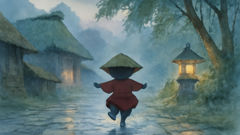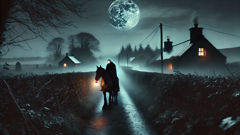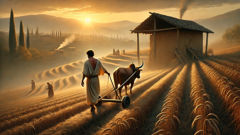Introduction
There are moments in the countryside of Japan when the rain falls so softly it feels like a song from the mountains. In those quiet hours, when the world is wrapped in mist and the earth’s breath rises from the rice fields, legends take on a life of their own. Among the most beloved is the tale of the Amefurikozo—the rain-child yokai. In the heart of a remote mountain village, old and young alike knew of this peculiar spirit: a small figure, neither wholly human nor entirely ghostly, said to appear on rainy evenings. The villagers would sometimes glimpse footprints in the mud where no child had played, hear laughter echoing near the flooded stone steps of the local shrine, and see ripples in puddles when the air was still. The Amefurikozo was more than a whisper on the wind; it was the living memory of childhood delight, mischief, and the eternal dance between people and the natural world. As farmers watched their crops drink from the sky’s bounty and children pressed their noses to fogged windows, stories were spun around the flickering hearth. Grandparents would tell of a time when the rain-child had appeared in their own youth, perhaps beneath the spreading branches of an ancient camphor tree or along the banks of a winding stream. These tales were not warnings, but gentle reminders: to respect the rain, to cherish the cycles of nature, and to greet each puddle not with annoyance, but with a sense of wonder. This is the story of how one village came to understand the true spirit behind their rainy evenings, and how a single encounter with the Amefurikozo could change the course of a life—and a community—forever.
Rainfall and Whispered Legends
In the mountain village of Kurogane, where stone walls curved along steep paths and bamboo forests hemmed the world in soft green, rain was both blessing and mystery. Villagers measured time by the rains—the first drizzle of spring that awakened the rice, the summer downpours that battered the rooftops, the autumn mists that curled along the ground. It was said that each shower brought with it echoes from the unseen realm, where spirits and humans brushed past one another like wind in reeds.
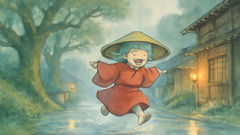
When evening storms rolled down from the peaks, children were drawn to the windows, eyes wide as drops streamed in silver sheets down the glass. The elders would gather near the warmth of the hearth, sipping tea, their voices low but animated. They shared tales that seemed to slip between reality and dream. Among all the yokai—the fox-spirits and river demons, the shape-shifting tanuki and lantern-bearing ghosts—none was more beloved than the Amefurikozo.
“He wears a hat of woven straw,” old Granny Sato would say, “and a kimono as red as the first camellia of spring. His laughter is softer than wind-chimes, and when you follow it, you’ll find nothing but ripples where his feet have danced.” Some said the Amefurikozo was a lost child, forgotten by time and kept alive by the rain’s memory. Others believed he was a spirit sent by the gods to remind people not to grumble at wet socks or muddy paths. Children would sometimes leave out rice cakes near puddles, hoping for a sign—a single wet footprint, a giggle in the night, or a paper umbrella left behind, trembling with dew.
But as with many tales, belief ebbed and flowed with the years. Some grown-ups, weighed down by the burden of harvests and repairs, dismissed such stories as childish fancy. Yet there was always one in every generation who saw what others could not, and in Kurogane that person was Yui, a girl of ten with a heart tuned to the world’s quiet music. Her mother called her ‘cloud-gazer’ because she’d sit for hours watching the sky shift above the fields. Yui believed in things others had forgotten: the rustle of invisible wings in the bamboo, the sense of eyes watching from rain-dark branches, and the gentle tug at her sleeve when she neared a puddle after dusk.
One spring night, when the thunder was distant and the rain fell in soft, steady curtains, Yui slipped from her futon. She couldn’t sleep—there was a humming in her bones, a feeling that something waited just beyond her window. Pulling on her faded blue yukata, she crept outside, careful not to wake her parents. The world was shimmering, every stone and leaf slick with water. In the lane, puddles gathered like silver mirrors, reflecting the glow of lanterns hung at doorways and the flicker of fireflies tangled in the mist. Yui’s toes curled against the cool stones as she wandered, drawn by the faintest sound—a splash, then another, rhythmic and playful.
Near the old camphor tree, whose roots had split the pavement in a lazy spiral, she saw him: small, half-hidden by shadows, head bowed beneath a wide straw hat. His kimono was indeed the red of camellias, and as he leapt from one puddle to the next, droplets arced around him in tiny rainbows. He spun, arms outstretched, and for a moment Yui was sure he looked right at her. The smile that flickered across his face was neither mischievous nor threatening, but gentle, inviting. He beckoned with one hand, and before she knew it, Yui was splashing after him, laughter bubbling up from somewhere deep inside.
They played among the puddles—leaping, spinning, sending up sprays of water that caught the lantern light and scattered it like scattered jewels. Yui felt as if she’d stepped into another world, one where worries washed away and only joy remained. When she finally paused, breathless and soaked to the skin, the Amefurikozo was already slipping away into the mist. He paused beneath the camphor’s dripping branches, tipped his hat in farewell, and melted into the rain.
Yui stood alone on the stone path, heart pounding, but the memory lingered like a promise: when the rain falls, magic walks among us, unseen but very real.
The Mystery Deepens
After that night, everything changed for Yui. She walked through her days with a secret tucked beneath her ribs—the knowledge that the world held more than what met the eye. Rainy evenings became her favorite time. When clouds gathered over the mountains and the scent of wet earth drifted through the village, Yui would watch for signs of her mysterious friend. Sometimes she glimpsed a small shadow darting behind a garden wall or found a puddle rippling though there was no wind.
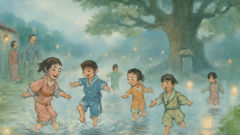
But Yui was not the only one affected by the rains that spring. The villagers noticed strange happenings. Laundry hung to dry would disappear, only to reappear folded at a neighbor’s doorstep. Rice cakes left near puddles vanished, but in their place appeared small tokens: a perfectly smooth stone, a folded paper crane made from mulberry bark, a sprig of moss shaped like a heart. Children’s laughter echoed in empty lanes long after everyone had gone inside.
Some elders began to worry that something restless had been awakened. Granny Sato, who knew every legend by heart, whispered that such signs meant the Amefurikozo was displeased. Others said he was lonely, longing for company as children grew too old for puddle games and adults hurried home before dark. The village priest, whose temple perched above the rice terraces, advised caution. “Respect the rain,” he said at every festival, “and do not mock what you do not understand.”
Yui grew torn between excitement and unease. She wanted to see the Amefurikozo again, but worried that she’d caused trouble for her neighbors. One afternoon, as the rain drummed a steady rhythm on the roof and her parents argued quietly about a missing ladle, Yui slipped away to seek answers from Granny Sato. The old woman sat on her porch, weaving bamboo strips into baskets, her eyes as sharp as ever. Yui poured out her heart—the games in the rain, the vanishing rice cakes, the strange gifts.
Granny listened in silence, then took Yui’s hands in hers. “The Amefurikozo is not a demon, nor a ghost to be feared. He’s a spirit of play—of joy that comes with the rain. But even joy needs balance. Too much or too little can bring disharmony. Long ago, before you were born, the rains failed for many seasons. The villagers forgot how to laugh when the skies darkened. It was the laughter of children that called the Amefurikozo back, and with him, the return of gentle rain.”
Yui felt a weight lift. “So I haven’t angered him?”
Granny smiled. “No, child. You’ve only reminded us what matters: kindness to one another and gratitude for what the rain brings. Next time you see him, thank him. And if you wish, invite others to join your game.”
That evening, a festival was held to honor the coming summer rains. Lanterns were floated down the river, their light bobbing on the current like tiny moons. Children were encouraged to splash in the puddles, to sing and dance as the Amefurikozo might. Yui led them, her laughter bright as bells. And though no one saw him that night, many felt as though an invisible hand guided their steps.
When Yui returned home, she found a folded paper crane on her pillow—a final token from her rain-child friend. From that day forward, the Amefurikozo’s legend grew richer. Adults learned to smile at muddy shoes, and the rains seemed gentler, more generous. For in Kurogane, every drop of rain became a reminder of play, connection, and the delicate harmony between humans and the world beyond.
Conclusion
The rain never again felt quite the same in Kurogane. It became more than weather; it was a gentle reminder of the unseen world that breathed alongside the villagers, nurturing their crops and hearts alike. Yui grew older, but she never lost her sense of wonder or her gratitude for each rainy evening. Whenever clouds gathered and droplets drummed their patient song on rooftops, she would pause by the camphor tree, hoping for a glimpse of red silk or the echo of distant laughter. Children told their own stories, and even skeptical grown-ups found themselves smiling at rippling puddles and mysterious gifts left at their doors. In this way, the spirit of the Amefurikozo endured—not only as a legend but as a living thread woven through every rainy day. To this day, travelers who visit Kurogane are warned: don’t rush indoors at the first sign of rain. Instead, look for small footprints in the mud, or listen for laughter where no child is seen. For somewhere beyond the mist, the rain-child still dances—and those who join in his games will carry a piece of that magic with them, long after the sun returns.

